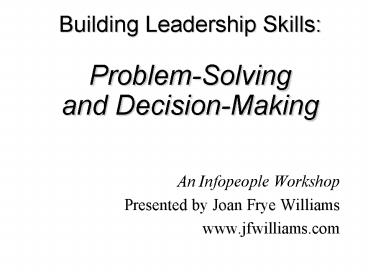Building Leadership Skills: ProblemSolving and DecisionMaking - PowerPoint PPT Presentation
1 / 38
Title:
Building Leadership Skills: ProblemSolving and DecisionMaking
Description:
Make sure your desired outcomes align clearly with the library's ... Perfectionism. Catastrophizing. Mixed feelings about success. Step #6: Make Your Decision ... – PowerPoint PPT presentation
Number of Views:243
Avg rating:3.0/5.0
Title: Building Leadership Skills: ProblemSolving and DecisionMaking
1
Building Leadership SkillsProblem-Solving and
Decision-Making
- An Infopeople Workshop
- Presented by Joan Frye Williams
- www.jfwilliams.com
2
Not All Decisions Require Equal Attention
3
Decision Insurance
- Define the problem
- Gather additional data
- Lay it all out
- Identify your options
- Evaluate your options
- Make your decision
- Move forward
4
Step 1Define the Problem
- What?
- Where?
- How?
- When?
- With whom?
- Why?
5
For a Complex Problem
- Break it down
- Verify with others
- Prioritize
6
Describe the Desired Outcome(s)
- Define the solved state
- Heres what should be happening
7
Identify Specific, Measurable Goals
- What are we trying to
- Achieve?
- Preserve?
- Avoid?
- Eliminate?
8
Link Back to the Big Picture
- Make sure your desired outcomes align clearly
with the librarys mission and strategic plan
9
Reality CheckDecision Politics
- Who are the stakeholders in this situation?
- What will they need to get out of any decision?
- How and when should they participate in finding a
solution?
10
Step 2Gather Additional Data
- Broad
- Objective
- Verifiable
- Relevant
11
Beware
- Hearsay/rumor
- Opinion
- Wishful thinking
- Labeling the problem
- Blaming/scapegoating
- Vivid but minor evidence
12
Look Outside the Library as Well as In
13
Dont Overlook
- Your own beliefs and biases
- Your own (possible) role in the situation
14
How Much Information Is Enough?
15
Just Be Sure YouCover the Bases
- Bouncing around is natural
- More information may accrue over time
16
Step 3Lay It All Out
17
Pareto Analysis
- 80/20 rule
- Focus on numerical data
- Use to identify
- which situations are most common
18
Mind Mapping
- Free-form note taking
- Any kind of information
- Use to show how different facts relate to the
problem - and to each other
19
Look into Causes but Dont Bog Down
- Not all problems are caused
- Not all causes can be corrected
- Ask for input one person at a time.
20
The Un-ProblemAppreciative Inquiry
- Systematic discovery of the best in people and
organizations - Unconditional positive questions
- Directed conversation and storytelling
- What is working well?
- How can we do more of that?
21
Step 4Identify Your Options
- What options do we have?
- What has been done in other libraries?
- In other disciplines?
- How about something new?
22
SituationSomethings Gone Wrong
- Find and correct the changes that account for the
fall-off in results.
23
SituationIncreased or Changing Expectations
- Find new ways of operating.
24
SituationThe Double Whammy
- Find ways to reengineer the system correct and
invent.
25
SituationIt Never Did Work Right
- Find ways to overhaul or completely rebuild.
26
Things That Can Limit Your Thinking
- Searching for THE ONE RIGHT ANSWER
- Not involving front line people
- Looking inside the library only
- Waiting for 100 agreement
- Fear of embarrassment or failure
27
Be Sure to Include
- Current approach
- Something new
- Something fun
28
Step 5Evaluate Your Options
29
Check Sheet
30
SWOT Strengths Weaknesses Opportunities
ThreatsPMIPlus Minus - Interesting
31
Six Thinking Hats
32
Think Through Risks and Consequences
- Reversible?
- Pilot-able?
- Timely?
- Politically sensitive?
33
Special Challenges in Many Library Environments
- Perfectionism
- Catastrophizing
- Mixed feelings about success
34
Step 6Make Your Decision
35
Reality CheckStrategic Thinking
- How might this decision change the librarys
position or reputation? - Will it set the stage or define a pattern for
future decisions? - Do library stakeholders need a heads-up?
- Who will get credit if things turn out well?
36
Take Time to Write a Brief Summary of Your Process
37
Step 7Move Forward
- Communicate the decision/solution
- Plan the implementation
- Monitor results
- Learn as you go
38
When Things Go Wrong
- Work each problem
- Re-prioritize if necessary
- Maintain focus on desired outcomes
- After a fair trial, change options































